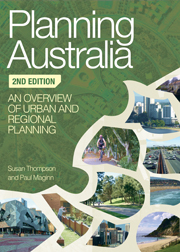Book contents
- Frontmatter
- Contents
- Contributors
- Figures and tables
- Discussion points and case studies
- Preface
- Acknowledgments
- Abbreviations
- Table of statutes
- Introduction
- Part I Frameworks
- Part II Key Issues
- 6 Planning and the natural environment
- 7 The metropolis
- 8 Planning for rural landscapes
- 9 Planning for regions
- 10 Planning for diverse communities
- 11 Aboriginal and Torres Strait Islander Australians
- 12 Community participation in planning
- 13 Urban design
- 14 Planning for heritage conservation and management
- 15 Transport planning
- 16 Healthy planning
- Conclusion: planning Australia into the future
- Index
- References
9 - Planning for regions
from Part II - Key Issues
- Frontmatter
- Contents
- Contributors
- Figures and tables
- Discussion points and case studies
- Preface
- Acknowledgments
- Abbreviations
- Table of statutes
- Introduction
- Part I Frameworks
- Part II Key Issues
- 6 Planning and the natural environment
- 7 The metropolis
- 8 Planning for rural landscapes
- 9 Planning for regions
- 10 Planning for diverse communities
- 11 Aboriginal and Torres Strait Islander Australians
- 12 Community participation in planning
- 13 Urban design
- 14 Planning for heritage conservation and management
- 15 Transport planning
- 16 Healthy planning
- Conclusion: planning Australia into the future
- Index
- References
Summary
Key terms: region; regionalism; regionalisation; regional planning; regional governance; regional development; spatial planning; new regionalism; government involvement.
Regional planning, regional policy and regional governance are contentious topics. There is debate about what properly constitutes a ‘region’, as there is about the form, role and scope of planning in and for regions (Beer, Maude & Pritchard 2003). At the same time, the responsibility for regions and regional planning is currently spread across many levels of government as well as non-elected bodies. It is not surprising, then, that many in the planning community regard the current state of regional planning in Australia as unsatisfactory. Planners who propose a commitment to genuine spatial planning on the regional scale – that is, planning that attempts to integrate social, economic and environmental objectives for regions that are larger than local government areas and smaller than states – face a very significant challenge. To meet it, they must go beyond traditional land-use planning and regulation.
Within this context, the chapter defines regions, regional planning and regionalism; outlines the main arguments for regional-scale spatial planning; describes government involvement in Australian regional planning; explains the main challenges for regional planning in Australia; and proposes options for good regional governance. In doing so, the chapter demonstrates the close relationships between regional governance and regional development in Australia. Regional planning is advocated in the form of spatial planning rather than land-use regulation, but the advantages of the former are weighed against the realities of Australian planning and governance regimes and the absence of agreement over what constitutes a region.
- Type
- Chapter
- Information
- Planning AustraliaAn Overview of Urban and Regional Planning, pp. 204 - 225Publisher: Cambridge University PressPrint publication year: 2012
References
- 2
- Cited by



